Inspection Tools
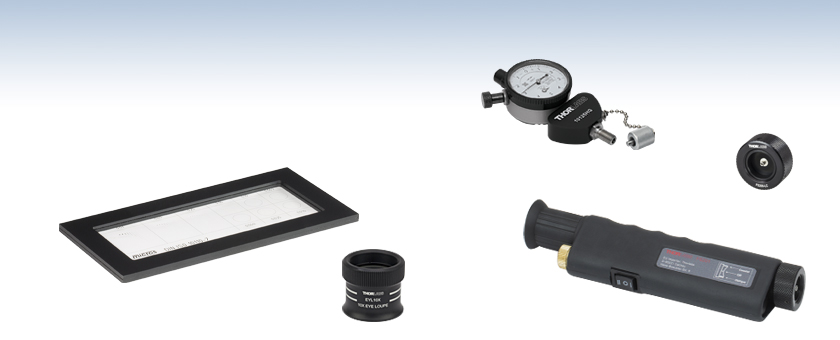
- Fiber Scope with 200X Magnification
- 6X and 10X Eye Loupes
- Inspection Mirror and Fiber Inspection Scope
- Scratch-Dig Panels for ISO and MIL Standards
MOTP-ISO
Scratch-Dig Panel
FS200-LC
LC Adapter for
FS201 Scope
FS201
Fiber Inspection Scope
EYL10X
10X Eye Loupe
10125HG
SMA Height Gauge
FS201
Fiber Inspection Scope

Please Wait
| Quick Links |
|---|
| Fiber Inspection Scope |
| Connector Adapters |
| SMA Height Gauge |
| Eye Loupes |
| Scratch-Dig Panels |
| Inspection Mirror |
Features
- Fiber Inspection Scope to Examine Fiber Polish Quality
- SMA Height Gauge for Connector Coupling Applications
- Eye Loupes Provide 6X or 10X Magnification
- Uncertified Scratch-Dig Paddle for Optic Surface Inspection
- Certified Scratch-Dig Panels for Optic Surface Inspection
- Inspection Mirror with Telescoping Handle
The tools on this page are primarily used for inspecting fiber optic ends and other optics. A fiber inspection scope is used to examine the polished end of a terminated fiber. The scope illuminates and magnifies the fiber tip so scratches and other defects can be seen. An SMA connector height gauge provides a way to accurately measure the length of an SMA905 connector, which is important in SMA to SMA coupling. Our premium eye loupes with 6X or 10X magnification are ideal for use in quality control departments. We also offer an inspection mirror, an uncertified scratch-dig paddle, and certified scratch-dig panels for optic surface inspection.
| Posted Comments: | |
user
(posted 2024-02-16 15:19:47.767) It would be helpful if the FS200-LC was shaped like a common female LC bulkhead, where the LC connector should click into the head. cdolbashian
(posted 2024-03-11 03:29:11.0) Thank you for reaching out to us with this suggestion! I will pass this excellent suggestion along internally, as this seems like a great quality-of-life modification for these types of connectors. HS Park
(posted 2023-01-04 16:18:33.967) Hi guys, Do you happen to have any plan to retrieve FS200 on your line-up? The old one was just perfect and it seems like everyone in this field miss it. jgreschler
(posted 2023-01-05 09:06:27.0) Thank you for reaching out to Thorlabs. Currently the FS201 is the replacement inspection scope and is available for purchase from our catalogue. I have reached out to you directly do discuss features and performance of the replaced item. user
(posted 2021-05-06 03:29:20.617) It would be helpful if the batteries for the fiber inspection scope were available separately. YLohia
(posted 2021-05-06 02:00:48.0) Thank you for your feedback. The FS201 uses three LR44 button batteries that can be purchased from a variety of online and brick & mortar stores. We will consider offering this in the future. Barry Coyle
(posted 2021-02-22 12:47:18.66) Does this also accept the Diamond AVIMS fiber connector? If not, you should add that to you product list. YLohia
(posted 2021-02-24 10:02:47.0) Hello, these items do not accept the Diamond AVIMS connector types. We will consider adding such options to the catalog in the future. Vadim Makarov
(posted 2020-10-11 15:48:45.17) Guys can you please install a shutoff timer into FS201, to switch off the light after a couple minutes? All our batteries are dead within days, because everyone forgets to switch it off after use!
The old FS200 with a timed button activation was perfect. Why have you ever come with the idea to replace that with the switch?
Can I mail you our ten units of FS201 back and get FS200 in replacement? YLohia
(posted 2020-10-12 10:16:57.0) Hello, thank you for your feedback. We will consider adding this functionality to a future revision of the FS201. Unfortunately, we cannot offer the FS200 in replacement since it was obsoleted 5 years ago and we don't have any remaining stock. Vincent LIN
(posted 2020-06-22 07:10:10.853) Dear Sir/Madam
Could you kindly help check what the country of origin for the FS201 ? YLohia
(posted 2020-06-23 08:27:17.0) Thank you for contacting Thorlabs. The country of origin is China for the FS201. Saul Sadowsky
(posted 2020-05-24 12:57:49.66) We need the Fs201 FMA-SMA adapter. This needs to be a male SMA thread. Do you guys supply that.?? YLohia
(posted 2020-05-26 01:53:34.0) Thank you for contacting Thorlabs. Unfortunately, we do not offer this adapter with a male SMA thread. Wolfgang Löffler
(posted 2020-03-03 11:08:03.443) Hello, do you also have an angled APC adapter for the fiberscope, in particular the old ones (CL-200), but I also don't see it for the new one? IMO, this would be very useful!
Best regards, Wolfgang nbayconich
(posted 2019-09-23 01:59:02.0) Thank you for contacting Thorlabs. The FS201-PM can be used with FC/APC fiber connectors, however the ferrule cannot be rotated when viewing the fiber face as the FC/APC connector key is locked in place. Being that the FC/APC connectors have a slight angle in them them you may have to rotate the connector to get a a complete view of the surface since part of the surface may be slightly out of focus. user
(posted 2019-09-13 13:18:02.237) Is FS201-PM compatible with polarization-marauding single mode (FC/APC) fiber ? Tiberius Georgescu
(posted 2019-06-20 13:31:27.32) Good day!
We have an FS201 fiber inspector that has been misaligned(FS-200-FC ferrule);
1-Misalignment in the axial direction:
The optical fiber's tip is not in the focal plane of the microscope: in order to see the fiber, it must be pulled out by almost a half of the length inserted into the ferrule.
2-Misalignment in the transverse plane:
The fiber holder is also misaligned in the xy plane, in that the fiber end, held at the z offset described at point 1, is not centered with the axis of the microscope.
How do you recommend re-aligning the x,y,z offsets?
I tried inserting a fiber but I can not see its tip because of the z offset. Because there is little grip on the optical fiber, it is not held by friction.
How would you recommend realigning it?
Does the microscope have a z/axial adjustment or all that can be adjusted is the position of the ferule ?
Thank you! llamb
(posted 2019-06-21 11:01:01.0) Hello, thank you for contacting Thorlabs. The FS201 can be adjusted axially by rotating the eyepiece. There are 3 setscrews around the edge of the fiber connector adapter that can be adjusted to center the ferrule face in the field of view. I have reached out to you directly to help as well. If you encounter any further issues, please reach out to your local Tech Support team (techsupport.uk@thorlabs.com) for further troubleshooting. christian.marciniak
(posted 2018-10-08 15:20:01.363) Hey,
we have two of the FS201 and in both of them one of the LEDs broke after about a year (one of each kind). Is there a way we can repair them without sending them back?
Cheers nbayconich
(posted 2018-10-10 05:00:05.0) Thank you for contacting Thorlabs. We generally do not repair these fiberscopes at our facility. I will reach out to you directly to help troubleshoot the problems you are experiencing with these scopes. user
(posted 2018-06-10 19:55:09.2) Are the FS201 series connector adapters compatible with older inspection scope FS200? llamb
(posted 2018-06-12 11:26:12.0) Yes, all of the connector adapters are also compatible with the older FS200 Fiber Inspection Scope. steve
(posted 2016-02-29 18:04:12.013) Is the split in the nozzle of the FS200-FC adapter compatible for view the end of the ferrule on an E2000 style connector, where the spring loaded cover has to be pulled back? besembeson
(posted 2016-03-09 03:57:32.0) Response from Bweh at Thorlabs USA: This is not compatible with the E2000 style connector. makarov
(posted 2014-01-31 18:55:20.72) Is a separate adapter for SMA (3.16 mm diameter) ferrule supposed to be included with FS200? The adapter on the scope is for 2.5 mm ferrule, and I can't find another adapter... maybe we misplaced it?.. If there is an SMA adapter, what is its part number? jlow
(posted 2014-02-03 02:37:33.0) Respond from Jeremy at Thorlabs: An SMA adapter is included with each FS200. It is in the Velcro compartment inside of the provided fiber microscope case. We will contact you regarding a quote for the replacement if you have lost the adapter. user
(posted 2013-09-12 22:33:51.54) I recently had the oportunity to try out your "Premium" 6X and 10X eye loupes. Something was funny to me, so I measured the magnification. Turns out the 10X loupe is only 6X, and the 6X loupe is only 4X! This is why the field of view is so large and the distortion is low. I have a $4 set of loupes from Harbour Freight which are actually the magnification they claim. In that sense a &1 loupe outpreforms your $150 ones!
The only thing premium is your price. Maybe it is time for some new optical engineers? jlow
(posted 2013-09-16 08:28:00.0) Response from Jeremy at Thorlabs: Thank you for your feedback regarding our premium eye loupes. The lenses used in these premium eye loupes were chosen to provide the specified magnification at the working distance specified. Since you did not leave your e-mail address, can you write to us at techsupport@thorlabs.com please? We would be interested in a detailed discussion on how you received values different from what we determined by both design and testing. jrserra
(posted 2013-05-30 13:00:35.22) Is there a way to couple the FS200 to a CCD/CMOS camera to capture the inspection image? tcohen
(posted 2013-06-06 11:44:00.0) Response from Tim at Thorlabs: Thank you for contacting us. This was built with convenience of use in mind and does not have a direct way to interface to a CCD/CMOS camera. There are instruments that serve this functionality better and I will contact you to discuss this further. jjurado
(posted 2011-06-22 20:02:00.0) Response from Javier at Thorlabs to edward.flagg: Thank you very much for contacting us. We currently do not offer a bare fiber adapter for the CL-200 fiber scope. The thread specification for the adapter is 0.875-28 UN-2A. edward.flagg
(posted 2011-06-22 16:05:31.0) Dear Thorlabs, I have a CL-200 fiber scope with a FC adapter, but I would like to use it to view bare fibers. Is there a bare fiber adapter? Alternately, what is the diameter and pitch of the thread on the adapter so i can machine my own bare fiber holder. Thanks. Customer Email: edward.flagg@nist.gov This customer would like to be contacted. georg.simmerle
(posted 2009-07-31 16:58:24.0) Dear Sir, we have the CL-200 fiber-scope, but after excessive use the provided FC adapter plate is broken. Is it available and whats the part number? Best regards, Georg Simmerle jens
(posted 2009-07-31 11:03:33.0) A reply from Jens at Thorlabs: yes, we can offer that part, part number for that component is CL-200-FC-1. We will contact you directly with a quotation. Tyler
(posted 2008-10-22 09:19:04.0) A response from Tyler at Thorlabs to Donini: The CL-200 fiber scope has three flat-head adjustment screws on the end of the fiber scope that accepts the fiber that can be used to center the core of the fiber in the field of view. Thank you for submitting the question, I will add a note to the product presentation. info
(posted 2008-10-22 04:14:02.0) Dear Sir,
I recently bought a CL-200 with SMA adapter. It is almost perfect because the fiber core appears not in the center of the image. Is it normal? If not where where am I wrong?
Best regards,
Donini Maurizio |

| FS201 Specifications | |
|---|---|
| Optical Magnification | 200X |
| Field of View | ~Ø600 µm |
| Illumination | Coaxial and Oblique White LEDs (100 000 Hour Lifetime) |
| Optical Filter | Built-In IR Filter |
| Power | 3 LR44 Button Batteries (Included) |
| Included Adapters |
FS201-FC FS201-SMA |
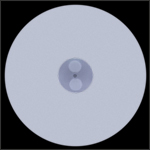
Click to Enlarge
Figure 221A View of PANDA-Style PM Fiber with the FS201 Inspection Scope and
- Critically Examine Fiber Polish Quality
- Scope Includes Two Fiber Adapters:
- FS201-FC: FC/PC, FC/APC, ST®*/PC, and SC/PC Connectors
- FS201-SMA: SMA905 and SMA906 Connectors
- Additional Connector Adapters Sold Separately Below
- Batteries are Included
The FS201 Fiber Inspection Scope produces a high-quality, low-distortion image of both the fiber end and surrounding ferrule. With a high-intensity illumination system and 200X magnification, this microscope is powerful enough to offer a clear image of the fiber core as well as the surrounding cladding. The FS201 offers both coaxial and oblique illumination settings. The coaxial setting provides symmetric lighting for high-detail inspection, and the oblique setting provides light at an off-center angle to the fiber end face for higher contrast. The FS201 should not be used to inspect a fiber connected to an active light source; light sources must be disconnected or turned off prior to inspection.
The FS201 includes the FS201-FC adapter for FC-/ST-/SC-terminated fibers (Ø2.5 mm ferrules) and the FS201-SMA adapter for SMA905- and SMA906-terminated fibers (Ø3 mm ferrules). The FS200-LC adapter for LC-terminated fibers (Ø1.25 mm ferrules) and the FS201-PM for polarization-maintaining fibers are available separately below.
Video 221B The FS201 features two illumination modes, as well as adjustable adapters for fiber alignment.
Fiber Scope Operation
Insert the fiber connector into the adapter until it stops and then firmly hold in place during inspection. To activate illumination, flip the switch on the bottom of the scope; "|" activates coaxial illumination, while "||" activates oblique illumination. Once finished, flip the switch back to "O" to turn the scope off.
To inspect the full surface area of fibers with larger cores or fibers with angled faces, it may be necessary to rotate the fiber connector. This is also useful for differentiating between contaminants on the face of the fiber connector and those on the scope optic itself. In order to see the entire field of view, the rubber eyepiece should be as close as possible to the operator's eye. Operators who normally wear eyeglasses should remove them to fully inspect the fiber. Please note that under normal operation, the focus adjustment knob should not be rotated to its limits. Doing so repeatedly may cause the unit to fail over time.
The FS201 should not be used to view an active emitting fiber. An attenuating laser safety filter in the FS201 reduces the risk of accidental viewing of active fiber emissions. However, due to the IR wavelengths commonly used in fiber optics, the natural aversion reflex to viewing bright light is suppressed and can result in a longer accidental exposure time. Therefore, Thorlabs recommends that light sources must be disconnected from the patch cable or turned off prior to inspection.
Adapter Alignment
Although each adapter comes pre-aligned for use with the FS201, it may be necessary to align the adapter to center the fiber in the field of view for fibers with poor centration. First, follow the basic steps above to inspect a test fiber. Using a 1.5 mm hex key or balldriver, loosen the three setscrews around the edge of the connector adapter at the end of the scope. Look through the illuminated scope, focus on the fiber ferrule, and align the connector until the ferrule face is centered within the field of view. Progressively adjust the three setscrews until the end face is in the center of the scope view.
*ST® is a registered trademark of Lucent Technologies, Inc.

- Connector Adapters Compatible with the FS201 Fiber Inspection Scope
- Options Available for FC, ST®*, SC, SMA905, SMA906, or LC Connector Types
- FS201-PM Adapter Features V-Groove Aligned to Wide Key Slot (2.2 mm) of the FC/PC Bulkhead
These connector adapters are used with the FS201 Fiber Inspection Scope sold above to enable compatibility with different ferrule and connector types (see Table 631A for options). The FS201-PM adapter is like the FS201-FC adapter, except it features a V-groove that is aligned with the wide key slot on the FC/PC bulkhead. This provides a rough guide for determining the relative alignment of the connector key to the fiber stress members when used with polarization-maintaining patch cables.
Although each adapter comes pre-aligned for use with the FS201, it may be necessary to align the adapter to center the fiber in the field of view for fibers with poor centration. First, follow the basic steps above to inspect a test fiber. Using a 1.5 mm hex key or balldriver, loosen the three setscrews around the edge of the connector adapter at the end of the scope. Look through the illuminated scope, focus on the fiber ferrule, and align the connector until the ferrule face is centered within the field of view. Progressively adjust the three setscrews until the end face is in the center of the scope view.
*ST® is a registered trademark of Lucent Technologies, Inc.

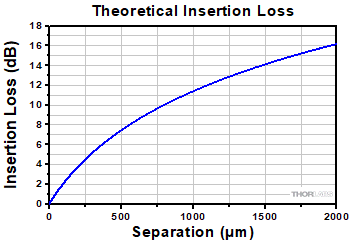
Click to Enlarge
Figure G3.1 Theoretical Insertion Loss Between Two SMA905 Connectors
- Measures SMA905 Ferrule Height Relative to 0.3860"
- Calibration Pin Included
- Detailed Calibration and Usage Instructions in Manual
The 10125HG SMA height gauge is ideal for accurately measuring the height of a polished fiber optic SMA905 connector. SMA-to-SMA couplers are designed to have a non-contact interface, and since the insertion loss (IL) of an SMA-SMA junction is dependent on the distance between the two SMA connector end faces, the height of the polished SMA connector is important. We recommend frequent calibration using the attached calibration pin. For detailed calibration instructions, please see the manual. Please note that this gauge is not compatible with SMA906 connectors.
To use, thread an SMA905-terminated fiber into the port at the bottom of the gauge and hand tighten. The connector height measurement on the gauge face is with respect to 0.3860". The photo above shows a ferrule with a height of 0.3863" which reads as +3 ticks on the gauge face. Be sure the gauge is properly calibrated prior to use.
Please note the IEC standard for SMA ferrule height is 0.3850" to 0.3863" (IEC61754-22).
Figure G3.1 shows the theoretical insertion loss as a function of the separation of two SMA connectors using our M38L01 patch cable. The fiber in this cable has a core diameter of 200 µm, a numerical aperture of 0.39, and an index of 1.4571 at 633 nm. This graph was generated using the following equation:

where z is the separation distance, a is the radius of the core size in µm, NA is the numerical aperture of the fiber, and n0 is the index of the core. Click here to download an interactive Excel file which can be used to calculate and graph the theoretical insertion loss for any fiber.
The height gauge should not be used for testing high-power fiber patch cables as the contact between the gauge and connector end can damage the exposed fiber tip.

| Table G4.2 Specifications | ||
|---|---|---|
| Item # | EYL06X | EYL10X |
| Magnification | 6X | 10X |
| Working Distancea | 30 mm (1.2") | 20 mm (0.8") |
| Field of View | 35 mm (1.4") | 27 mm (1.1") |
| Clear Aperture | Ø27.9 mm (Ø1.10") | |
| Surface Quality | 40-20 Scratch-Dig | |
| Lens Materials | N-BAF10/N-SF6HT | |
| Broadband AR Coating | ||
| Wavelength Range | ||
| Average Reflectance | <0.5% | |
- Magnification: 6X or 10X
- Uses a Pair of Glass Achromatic Doublets
- AR Coating on All Glass-to-Air Optical Surfaces
- Large Field of View: Ø1.4" for 6X and Ø1.1" for 10X
- Small Form Factor
Thorlabs' Premium Eye Loupes provide clear magnification that is ideal for inspecting optics and small parts. The eye loupes were designed by Thorlabs to maximize working distance when used with the knurled edge oriented towards the eye. They use a pair of glass achromatic doublets to minimize chromatic and other aberrations. The AR coating on each optical surface is optimized to reduce internal reflections at wavelengths visible to the human eye. These high-quality magnifiers are suitable for quality control applications in industry or inspecting optics in the lab. They are available in 6X and 10X magnifications.
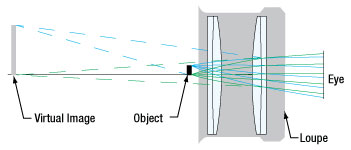
Click to Enlarge
Figure G4.3 This ray tracing demonstrates the virtual image seen through the EYL06X eye loupe.
Eye Loupe Magnification
The magnification specification provided for these eye loupes is determined using the standard magnification definition:
where M is the magnification, Himage is the image height, and Hobject is the object height. This definition is valid when used at the specified working distance. When using this equation, the magnification of EYL06X and EYL10X is 6.0 and 10.0, respectively, as specified in Table G4.2.
The maximum magnification that can be achieved on the human retina is given by the loupe magnification definition, which is a thin-lens formula:
where M is the magnification and f is the focal length of the lens in mm. When using this equation, the magnification of EYL06X is 5.5 and the magnification of EYL10X is 8.9.

- 10X Magnification
- Hastings Design
- Lightweight
This Bausch + Lomb® loupe is an ideal, economical tool for inspecting optics and small parts. The eyepiece provides a clear, 10X magnification. This loupe is designed to be used with the flared edge facing the eye. If the JEL10 does not meet your inspection needs, our premium eye loupes (featured above) provide a higher image quality and a wider field of view suitable for industry inspection applications.

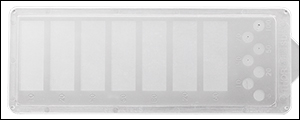
Click To Enlarge
Figure G6.1 Detail of SDP Surface Imperfection Standard
| Table G6.2 Measured Feature Dimensions of SDP Mold | |||
|---|---|---|---|
| Dig Number | Mean Dig Diameter | Dig Diameter Tolerance | Dig Separation Distance |
| 100 | 1.00 mm (0.040") | - | 20.00 mm (0.787") |
| 70 | 0.70 mm (0.028") | ||
| 50 | 0.50 mm (0.020") | ||
| 40 | 0.40 mm (0.016") | ±0.01016 mm (0.0004") | |
| 20 | 0.20 mm (0.008") | ±0.00762 mm (0.0003") | |
| 10 | 0.10 mm (0.004") | ±0.00508 mm (0.0002") | 1.00 mm (0.040") |
| 5 | 0.05 mm (0.002") | ±0.00338 mm (0.0001") | 1.00 mm (0.040") |
- Acrylic Molded Visual Scratch-Dig Reference for Optical Element Inspection
- Seven Different Sizes of Both Scratches and Digs
- Scratch-Dig Defined According to MIL-PRF-13830B
Scratch-dig paddles are used to determine the cosmetic surface quality of an optic. Made of acrylic and cast from a mold, Thorlabs' SDP Scratch-Dig Paddle contains 7 rectangular sections and 7 circular sections each of which contains a different scratch or a different dig. Scratch-dig refers to the cosmetic quality of the surface of an optic and is defined by the U.S. military (MIL-PRF-13830B). A scratch is defined as any marking or tearing of the glass surface and the digs are small rough spots on the glass surface, similar to pits in appearance. This reference contains scratch numbers 10, 20, 40, 60, 80, 120, and 160, and dig numbers 5, 10, 20, 40, 50, 70, and 100; the scratches are classified topographically and comply with MIL-PRF-13830B standards, while the mean diameter of each of the digs is physically measured. Table G6.2 shows measured feature dimensions for the digs in the molds used to create these paddles.
Although not certified, this paddle contains scratch and dig features that can be used as a reference to compare with any optic for classification. To use the paddle, place it next to the optic you are inspecting and compare the imperfections on the optic's surface to the imperfections on the paddle. We also offer Scratch-Dig Panels (sold below) that are fabricated photolithographically and conform to the ISO 10110-7 and ANSI/OEOSC OP1.002 standards.
Procedure:
The surface quality is to be specified by a number such as 60-40 scratch-dig. The first number corresponds to the max scratch width compared to the reference scratches on the SDP paddle. It does not correspond directly to a precise scratch width. The next number indicates the mean diameter of a dig in hundredths of a millimeter. Table G6.2 can be used to quickly convert the dig number into millimeters or inches.


Click To Enlarge
Figure G7.1 Detail of MOTP-ISO (Top) and MOTP-MILB (Bottom) Surface Imperfection Standards
- Visual Scratch-Dig References for Optical Element Inspection
- Two Quality Standards Available:
- MOTP-ISO: ISO 10110-7
- MOTP-MILB: MIL-PRF-13830B for Digs Numbered 5 to 50 and ANSI/OEOSC OP1.002 for All Digs and Scratches
- Borosilicate Substrate with Plastic Frame; Hard Foam Case Included
These Scratch-Dig Panels are a certified traceable option used to determine the cosmetic surface quality of an optic. We offer two scratch-dig panels, each with their own set of imperfections. For details and dimensions on the photolithographically marked patterns, please refer to Figure G7.1, Table G7.2, and Table G7.3.
The MOTP-ISO panel is defined by the ISO 10110-7 standard. The imperfections are evaluated and classified depending on their physical sizes with no distinction between a scratch and a dig. All imperfections can be considered scratches of different sizes.
The MOTP-MILB panel is defined by the ANSI/OEOSC OP1.002 standard for scratches and digs and also corresponds to the MIL-PRF-13830B standard for digs labeled 5 to 50. This panel places an emphasis on the shape of the imperfection and is divided in two parts, scratches and digs. The given grade numbers for the imperfections indicate scratch width in µm or dig diameter in 1/100 mm.
To use these panels, place them next to the optic under inspection and compare the imperfections on the optic's surface to the imperfections on the panel. Both of our panels are designed for use with dimensional analysis, which facilitates an unbiased qualification of the optic’s imperfections. Manufacturers and users are recommended to use the same standard.
Certificates with nominal and measured feature dimensions for the masks used to create these panels are available by clicking on the Support Docs icons (![]() ) below.
) below.
| Table G7.2 MOTP-ISO Panel Pattern Dimensions [ISO 10110-7] |
|---|
| Table G7.3 MOTP-MILB Panel Pattern Dimensions [ANSI/OEOSC OPI1.002 (Digs and Scratches) and MIL-PRF-13830B (Digs 5 to 50)] |
|---|

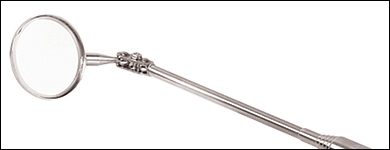
Click to Enlarge
Figure G8.1 Partial Extension of Telescoping Arm
- Corrosion-Resistant Stainless Steel Telescoping Handle
- High-Quality, Low Distortion Ø1.25" Glass Mirror
- Articulated Joint Adds Versatility in Mirror Positioning
- 8.50" (21.6 cm) Solid Length, 35" (88.9 cm) Extended Length
This telescoping inspection mirror is ideal for viewing components in hard-to-reach areas of the lab.
 Products Home
Products Home












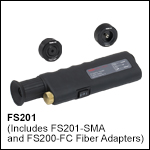
 Zoom
Zoom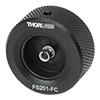
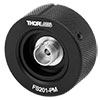
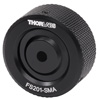

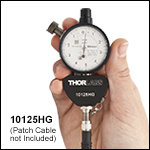
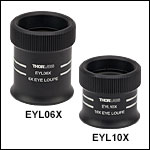
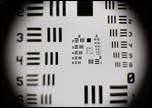
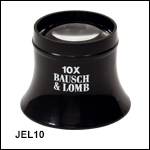
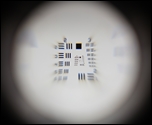
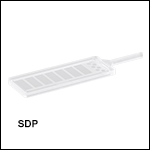
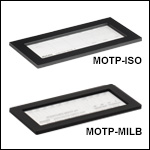
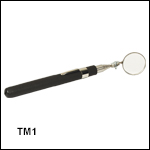
 Inspection Tools
Inspection Tools